Statistical Relations among Solid Precipitation, Atmospheric Moisture and Cloud Parameters in the Arctic
Abstract
1. Introduction
2. Data and Methods
3. Results
3.1. Influence of Supercooled Liquid on Snowfall Rates
3.2. Correlation of Snowfall Rate and IWP
3.3. Correlation of Snowfall Rate and Integrated Water Vapor
3.4. Correlation of Snowfall Rate with Surface Meteorology Parameters
4. Discussion and Conclusions
Funding
Institutional Review Board Statement
Informed Consent Statement
Data Availability Statement
Acknowledgments
Conflicts of Interest
References
- Tapiador, F.J.; Roca, R.; Del Genio, A.; Dewitte, B.; Petersen, W.; Zhang, F. Is Precipitation a Good Metric for Model Performance? Bull. Am. Meteor. Soc. 2019, 100, 223–233. [Google Scholar] [CrossRef] [PubMed]
- England, M.R.; Eisenman, I.; Lutsko, N.J.; Wagner, T.J.W. The recent emergence of Arctic Amplification. Geophys. Res. Lett. 2021, 48, 2021GL094086. [Google Scholar] [CrossRef]
- Bretherton, C.S.; Peters, M.E.; Back, L.E. Relationships between water vapor path and precipitation over the tropical oceans. J. Clim. 2004, 17, 1517–1528. [Google Scholar] [CrossRef]
- Ahmed, F.; Schumacher, C. Convective and stratiform components of the precipitation-moisture relationship. Geophys. Res. Lett. 2015, 42, 10453–10462. [Google Scholar] [CrossRef]
- Priego, E.; Jones, J.; Porres, M.; Seco, A. Monitoring water vapor with GNSS during a heavy rainfall event in the Spanish Mediterranean area. Geomat. Nat. Hazards Risk 2017, 8, 282–294. [Google Scholar] [CrossRef]
- Adams, D.K.; Barbosa, H.M.J.; Gaitán De Los Ríos, K.P. A spatiotemporal water vapor–deep convection correlation metric derived from the Amazon dense GNSS meteorological network. Mon. Weather Rev. 2017, 145, 279–288. [Google Scholar] [CrossRef]
- Fujita, M.; Sato, T. Observed behaviors of precipitable water vapor and precipitation intensity in response to upper air profile estimated from surface air temperature. Sci. Rep. 2017, 7, 4233. [Google Scholar] [CrossRef]
- Neelin, J.D.; Martinez-Villalobos, C.; Stechmann, S.N.; Ahmed, F.; Chen, G.; Norris, J.M.; Kuo, Y.; Lenderink, G. Precipitation extremes and water vapor. Curr. Clim. Chang. Rep. 2022, 8, 17–33. [Google Scholar] [CrossRef]
- Zhang, Z.; Lou, Y.; Zhang, W.; Liang, H.; Bai, J.; Song, W. Correlation analysis between precipitation and precipitable water vapor over China based on 199-2015 ground-based GPS observations. J. Appl. Meteorol. Clim. 2022, 61, 1663–1677. [Google Scholar] [CrossRef]
- Li, H.; Choy, S.; Zaminpardaz, S.; Carter, B.; Sun, C.; Purwar, S.; Liang, H.; Li, L.; Wang, X. Investigating the Inter-Relationships among Multiple Atmospheric Variables and Their Responses to Precipitation. Atmosphere 2023, 14, 571. [Google Scholar] [CrossRef]
- Hagos, S.M.; Leung, L.R.; Garuba, O.A.; Demont, C.; Harrop, B.; Lu, J.; Ahn, M. The relation between precipitation and precipitable water in CMIP6 simulations and implication for tropical climatology and change. J. Clim. 2021, 34, 1587–1600. [Google Scholar] [CrossRef]
- Liu, J.; Curry, J.A.; Wang, H.; Song, M.; Horton, M.H. Impact of declining Arctic sea ice on winter snowfall. Proc. Natl. Acad. Sci. USA 2012, 109, 4074–4079. [Google Scholar] [CrossRef] [PubMed]
- Shupe, M.D.; Rex, M.; Dethloff, K.; Damm, E.; Fong, A.A.; Gradinger, R.; Heuze, C.; Loose, B.; Makarov, A.; Maslowski, W.; et al. The MOSAiC Expedition: A Year Drifting with the Arctic Sea Ice. In Arctic Report Card 2020; Thoman, R.L., Richter-Menge, J., Druckenmiller, M.L., Eds.; NOAA: Washington, DC, USA, 2020. [Google Scholar] [CrossRef]
- Bharadwaj, N.; Lindenmaier, I.; Feng, Y.; Johnson, K.; Nelson, D.; Isom, B.; Hardin, J.; Matthews, A.; Wendler, T.; Castro, V.; et al. Atmospheric Radiation Measurement (ARM) User Facility. Ka ARM Zenith Radar (KAZRGE). 2017-11-01 to 2018-04-30, North Slope Alaska (NSA) Central Facility, Barrow AK (C1); ARM Data Center: Washington, DC, USA, 2011. [Google Scholar] [CrossRef]
- Lindenmaier, I.; Feng, Y.; Johnson, K.; Nelson, D.; Isom, B.; Hardin, J.; Matthews, A.; Wendler, T.; Castro, V.; Deng, M. Atmospheric Radiation Measurement (ARM) User Facility. Ka ARM Zenith Radar (KAZRCFRGE). 2019-10-11 to 2020-10-01, ARM Mobile Facility (MOS) MOSAIC (Drifting Obs—Study of Arctic Climate); AMF2 (M1); ARM Data Center: Washington, DC, USA, 2019. [Google Scholar] [CrossRef]
- Matrosov, S.Y.; Shupe, M.D.; Uttal, T. High temporal resolution estimates of Arctic snowfall rates emphasizing gauge and radar-based retrievals from the MOSAiC expedition. Elem. Sci. Anthr. 2022, 10, 00101. [Google Scholar] [CrossRef]
- Goodison, B.E.; Klemm, S.; Sevruk, B. WMO Solid Precipitation Measurement Intercomparison; TECO-1988 WMO/TD-No. 222, WMO: Geneva, Switzerland, 1988; pp. 255–262. Available online: https://library.wmo.int/idurl/4/28336 (accessed on 21 October 2021).
- Werner, K.; Goessling, H.; Jung, T.; Hoke, W.; Pasqualetto, S.; Kirchhoff, K. The Year of Polar Prediction—Developments and Prospects through Three Special Observing Periods. In Proceedings of the EGU General Assembly 2019, Vienna, Austria, 7–12 April 2019; Available online: https://meetingorganizer.copernicus.org/EGU2019/EGU2019-12762.pdf (accessed on 21 October 2021).
- Xia, X.; Fu, D.; Shao, W.; Jiang, R.; Wu, S.; Zhang, P.; Yang, D.; Xia, X. Retrieving precipitable water vapor over land from satellite passive microwave radiometer measurements using automated machine learning. Geophys. Res. Lett. 2023, 50, e2023GL105197. [Google Scholar] [CrossRef]
- Zhang, D. Atmospheric Radiation Measurement (ARM) User Facility. MWR Retrievals (MWRRET1LILJCLOU). 2017-11-01 to 2018-04-30, North Slope Alaska (NSA) Central Facility, Barrow AK (C1); ARM Data Center: Washington, DC, USA, 2011. [Google Scholar] [CrossRef]
- Zhang, D. Atmospheric Radiation Measurement (ARM) User Facility. MWR Retrievals (MWRRET1LILJCLOU). 2019-10-11 to 2020-10-01, ARM Mobile Facility (MOS) MOSAIC (Drifting Obs—Study of Arctic Climate); AMF2 (M1); ARM Data Center: Washington, DC, USA, 2019. [Google Scholar] [CrossRef]
- Matrosov, S.Y. Frozen hydrometeor terminal fall velocity dependence on particle habit and riming as observed by vertically-pointing radars. J. Appl. Meteorol. Clim. 2023, 62, 1023–1038. [Google Scholar] [CrossRef]
- Liu, C.-L.; Illingworth, A.J. Toward more accurate retrievals of ice water content from radar measurements of clouds. J. Appl. Meteor. 2000, 39, 1130–1146. [Google Scholar] [CrossRef]
- Morrison, H.; de Boer, G.; Feingold, G.; Harrington, J.; Shupe, M.D.; Sulia, K. Resilience of persistent Arctic mixed-phase clouds. Nat. Geosci. 2012, 5, 11–17. Available online: https://www.nature.com/articles/ngeo1332 (accessed on 21 October 2021). [CrossRef]
- Kyrouac, J.; Shi, Y. Atmospheric Radiation Measurement (ARM) User Facility. Surface Meteorological Instrumentation (MET). 2017-11-01 to 2018-04-30, North Slope Alaska (NSA) Central Facility, Barrow AK (C1); ARM Data Center: Washington, DC, USA, 2003. [Google Scholar] [CrossRef]
- Kyrouac, J.; Shi, Y. Atmospheric Radiation Measurement (ARM) User Facility. Surface Meteorological Instrumentation (MET). 2019-10-15 to 2020-09-18, ARM Mobile Facility (MOS) Collocated Instruments on Ice (S3); ARM Data Center: Washington, DC, USA, 2019. [Google Scholar] [CrossRef]
- Matrosov, S.Y. Variability of microphysical parameters in high-altitude ice clouds: Results of the remote sensing method. J. Appl. Meteor. 1997, 36, 633–648. [Google Scholar] [CrossRef]
- Matrosov, S.Y.; Heymsfield, A.J. Estimating ice content and extinction in precipitating cloud systems from CloudSat radar measurements. J. Geophys. Res. 2008, 113, D00A05. [Google Scholar] [CrossRef]
- Ambaum, M.H.P. Accurate, simple equation for saturated vapour pressure over water and ice. Q. J. R. Meteorol. Soc. 2020, 146, 4252–4258. [Google Scholar] [CrossRef]
- Falconi, M.T.; von Lerber, A.; Ori, D.; Marzano, F.S.; Moisseev, D. Snowfall retrieval at X, Ka and W bands: Consistency of backscattering and microphysical properties using BAECC ground-based measurements. Atmos. Meas. Tech. 2018, 11, 3059–3079. [Google Scholar] [CrossRef]
- Nixdorf, U.; Dethloff, K.; Rex, M.; Shupe, M.; Sommerfeld, A.; Perovich, D.K.; Nicolaus, M.; Heuze, C.; Rabe, B.; Loose, B.; et al. 2021: MOSAiC Extended Acknowledgement. Zenodo Open Repository, Operated by CERN—The European Organization for Nuclear Research. Available online: https://zenodo.org/records/5541624 (accessed on 21 October 2021).
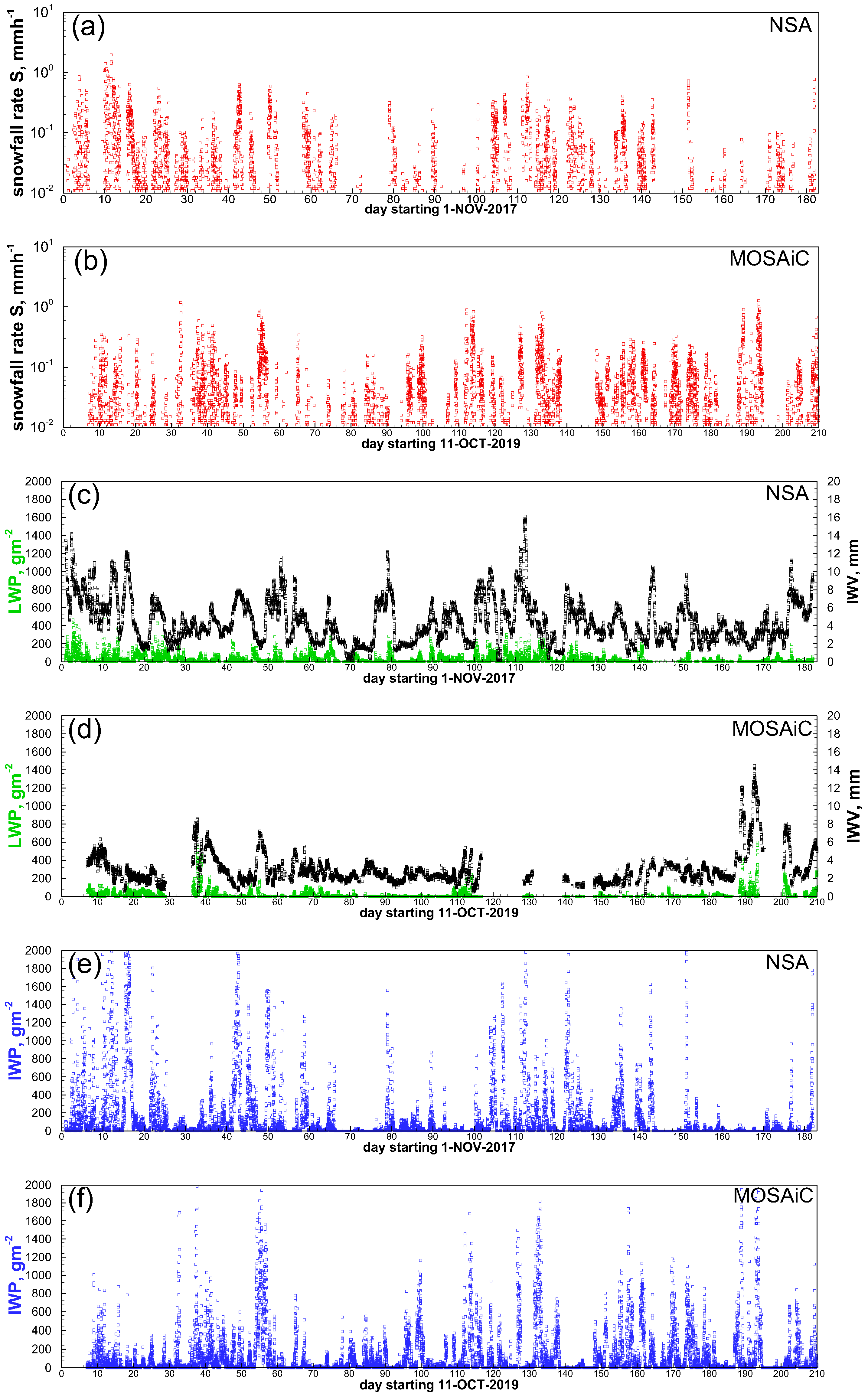
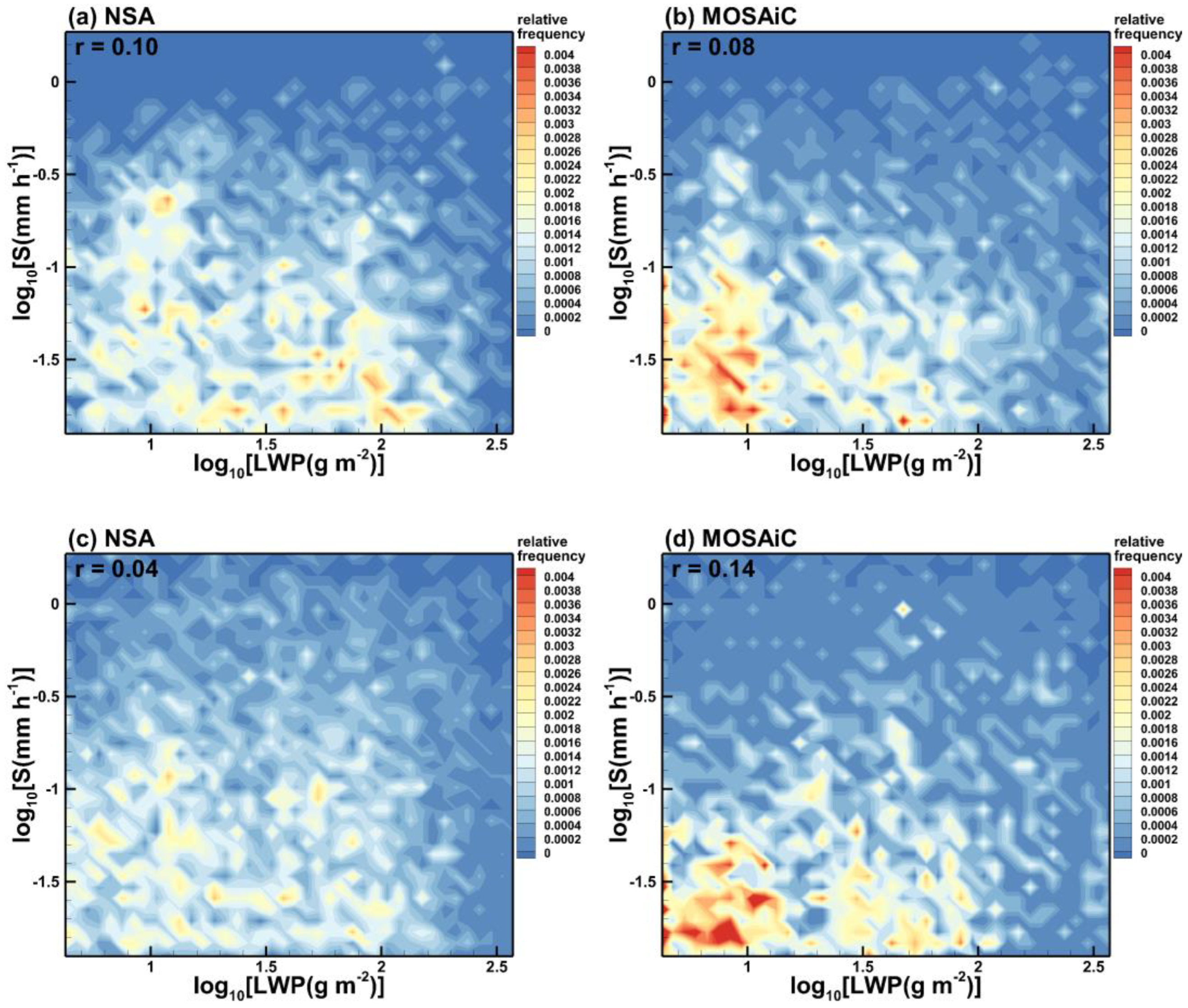

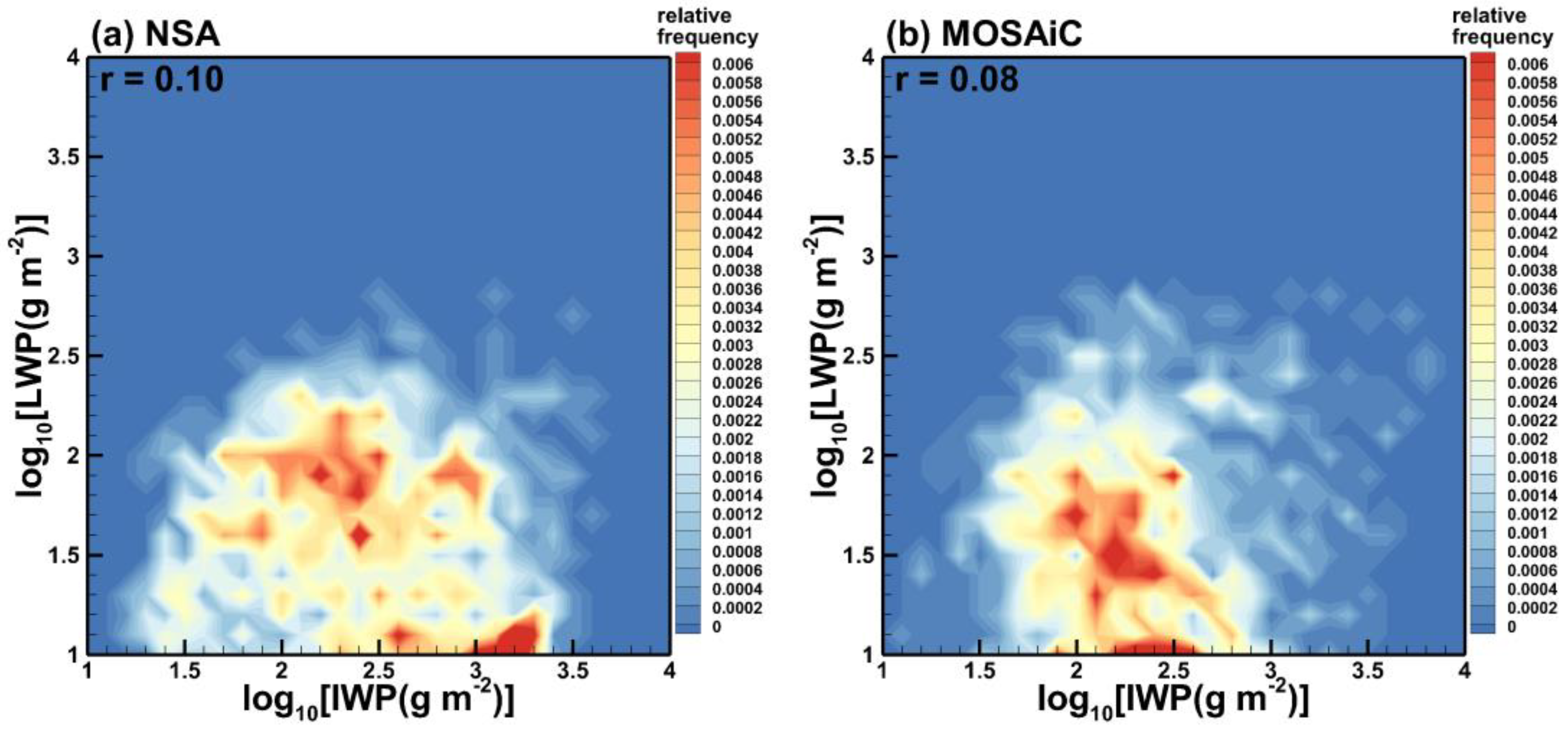
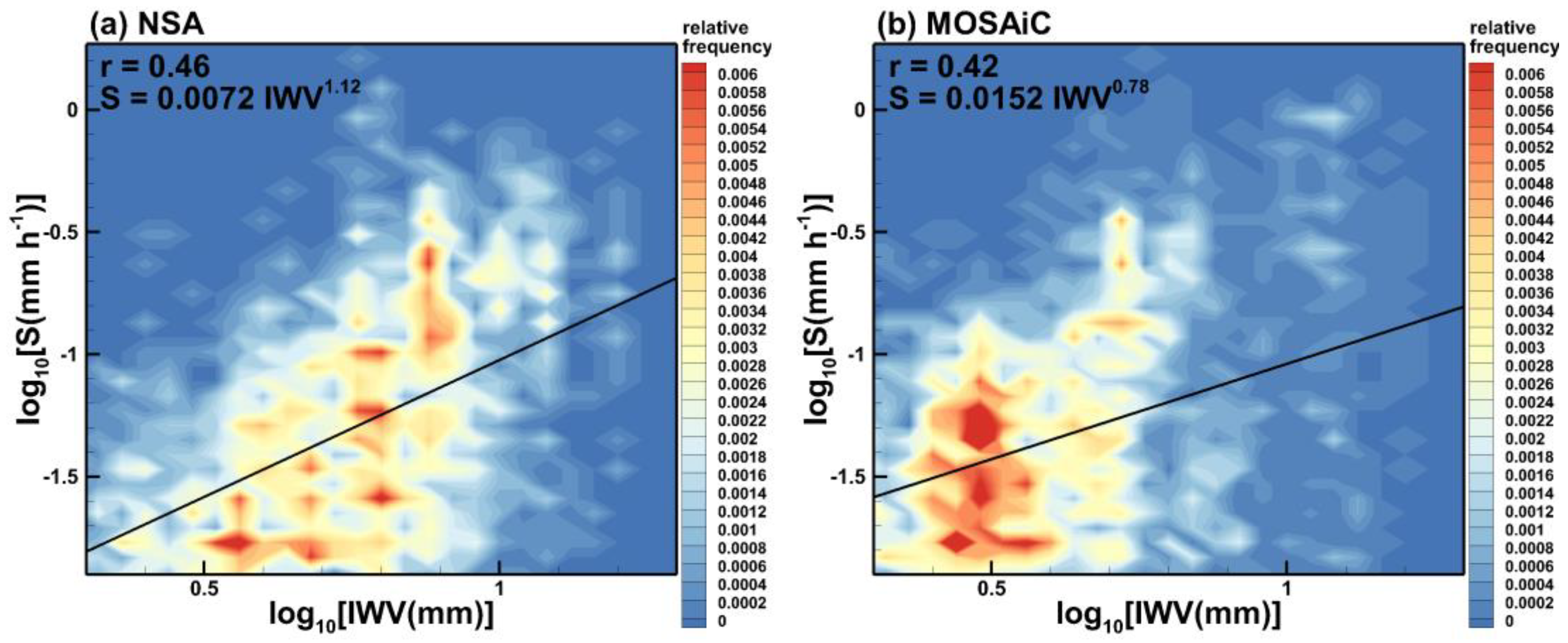
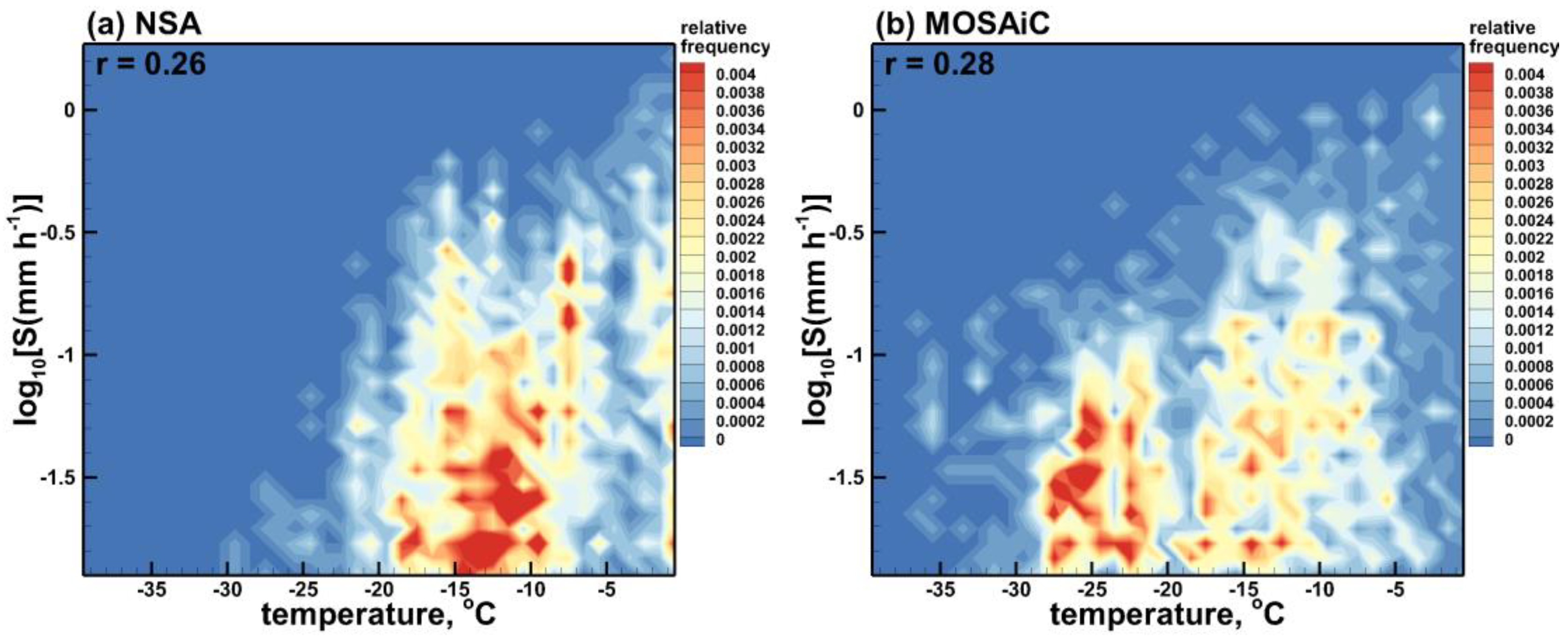
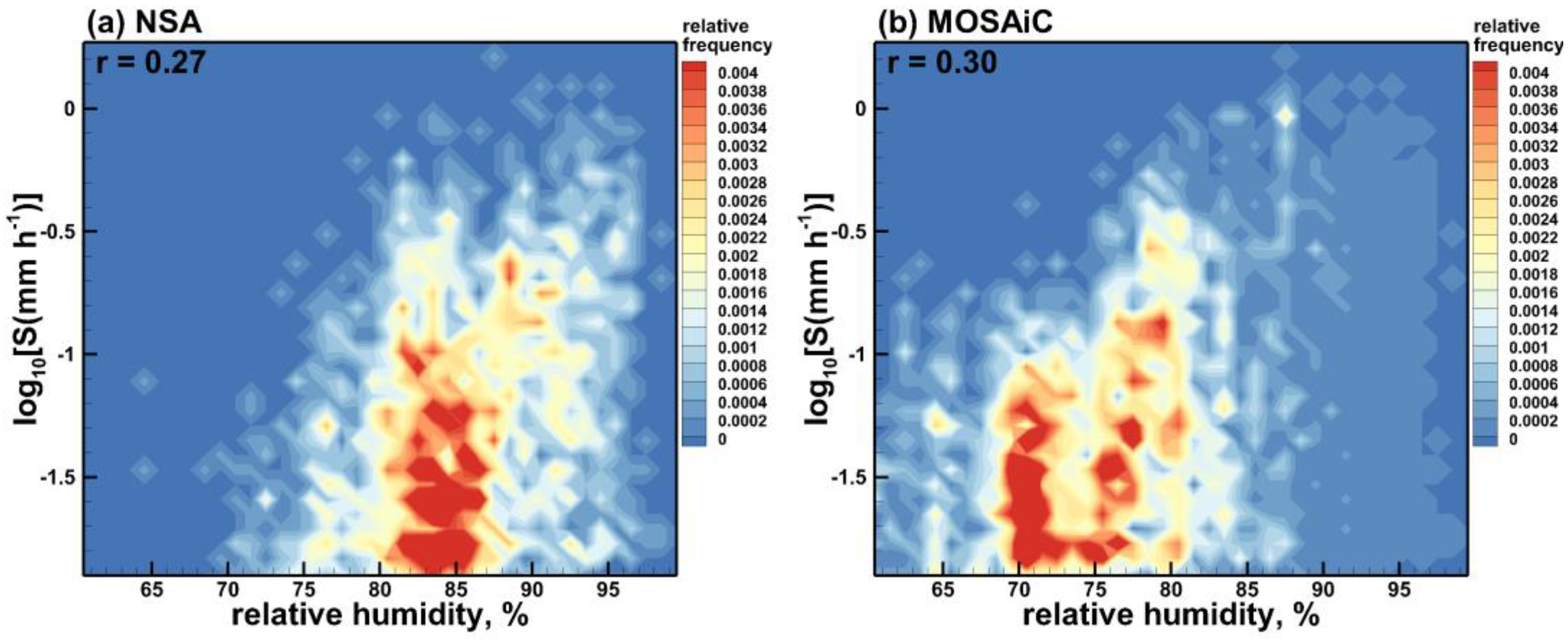
Disclaimer/Publisher’s Note: The statements, opinions and data contained in all publications are solely those of the individual author(s) and contributor(s) and not of MDPI and/or the editor(s). MDPI and/or the editor(s) disclaim responsibility for any injury to people or property resulting from any ideas, methods, instructions or products referred to in the content. |
© 2024 by the author. Licensee MDPI, Basel, Switzerland. This article is an open access article distributed under the terms and conditions of the Creative Commons Attribution (CC BY) license (https://creativecommons.org/licenses/by/4.0/).
Share and Cite
Matrosov, S.Y. Statistical Relations among Solid Precipitation, Atmospheric Moisture and Cloud Parameters in the Arctic. Atmosphere 2024, 15, 132. https://doi.org/10.3390/atmos15010132
Matrosov SY. Statistical Relations among Solid Precipitation, Atmospheric Moisture and Cloud Parameters in the Arctic. Atmosphere. 2024; 15(1):132. https://doi.org/10.3390/atmos15010132
Chicago/Turabian StyleMatrosov, Sergey Y. 2024. "Statistical Relations among Solid Precipitation, Atmospheric Moisture and Cloud Parameters in the Arctic" Atmosphere 15, no. 1: 132. https://doi.org/10.3390/atmos15010132
APA StyleMatrosov, S. Y. (2024). Statistical Relations among Solid Precipitation, Atmospheric Moisture and Cloud Parameters in the Arctic. Atmosphere, 15(1), 132. https://doi.org/10.3390/atmos15010132





